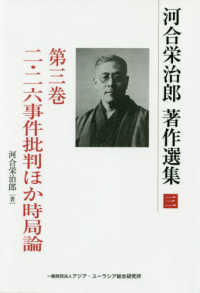- ホーム
- > 洋書
- > 英文書
- > History / World
Full Description
While scholars have long documented the migration of people in ancient and medieval times, they have paid less attention to those who traveled across borders with some regularity. This study of early transnational relations explores the routine interaction of people across the boundaries of empires, tribal confederacies, kingdoms, and city-states, paying particular attention to the role of long-distance trade along the Silk Road and maritime trade routes. It examines the obstacles voyagers faced, including limited travel and communication capabilities, relatively poor geographical knowledge, and the dangers of a fragmented and shifting political landscape, and offers profiles of better-known transnational elites such as the Hellenic scholar Herodotus and the Venetian merchant Marco Polo, as well lesser known servants, merchants, and sailors. By revealing the important political, economic, and cultural role cross-border trade and travel played in ancient society, this work demonstrates that transnationalism is not unique to modern times.
Instructors considering this book for use in a course may request an examination copy here.
Contents
Table of Contents
Preface
Introduction
1. Basic Features of Transnationalism in the Ancient and Medieval World
Societal Types
Contexts
Motivations and Personnel
Transportation and Communication
2. Ancient Empires
The Middle East
South Asia
The Roman Empire
East Asia
3. Medieval Empires
The Byzantine Empire
South Asia
The Caliphates
The Tang and Song Empires
The Mongol Empires
The Aztec Empire
4. Polities Along the Major Trade Routes
The Yuezhi-Kushan
Tamil Kingdoms
Malay Kingdoms
5. Long-distance Trade Goods
Obsidian
Beads
Textiles
Copper and Bronze
Gemstones
Incense
Tropical Spices
Tea
6. Long-distance Traders
Phoenicians
Greeks
Sogdians
Trans-Saharan Caravan Traders
Vikings
Nestorian Christians
Radhanites and Other Jewish Traders
Marco Polo and the Venetians
Gujaratis
Ryukyuans
Aztec Traders
7. Merchant Communities
The Middle East
South Asia
Melaka
Guangzhou
Western Europe
8. Cities
Mesopotamian Cities
Mediterranean Cities
South Asian Cities
East Asian Cities
Southeast Asian Cities
New World Cities: Teotihuacán
9. Soldiers
Mercenaries in the Ancient Mediterranean
The Roman Empire's Army
Medieval Mercenaries in Europe
Chinese Imperial Armies
The Aztec Military
10. Monks and Scholars
Transnational Buddhists
Hellenic Scholars
Transnational Christians
Transnational Muslims
Notes
Bibliography
Index
-

- 電子書籍
- 天才錬金術師は気ままに旅する【分冊版】…
-

- 電子書籍
- 左遷された無能王子は実力を隠したい【分…
-

- 電子書籍
- あなたなんて死ねばいいのに【タテヨミ】…
-

- 電子書籍
- 転生女優奇譚【タテヨミ】第43話 pi…




